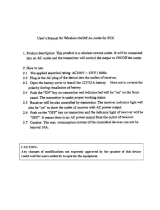
Working Range
Line of Sight
30 m (100 ft)
Note: Actual range depends on RF signal absorption, reflection and interference.
Frequency Stability
±10 ppm
Modulation
FM, 45 kHz max. deviation
Power Requirements
2 LR6 AA batteries, 1.5 V, alkaline
Power Consumption
@3 V
Display backlight on 220 mA, ±30 mA
Display backlight off 175 mA, ±30 mA
Power Consumption (X4, X7)
@3 V
Display backlight on 245 mA, ±30 mA
Display backlight off 200 mA, ±30 mA
Battery Life
>8 hours (alkaline)
Operating Temperature Range
-18°C (0°F) to +57°C (135°F)
Note: Battery characteristics may limit this range.
Dimensions
43 mm x 87 mm x 148 mm (H x W x D)
Weight
MX690 MX890
Net 319 g (11.2 oz.) 312 g (11 oz.)
Packaged 516 g (18.2 oz.) 530 g (18.7 oz.)
Specifications
IMPORTANT SAFETY INSTRUCTIONS
1. READ these instructions.
2. KEEP these instructions.
3. HEED all warnings.
4. FOLLOW all instructions.
5. DO NOT use this apparatus near water.
6. CLEAN ONLY with dry cloth.
7. DO NOT block any ventilation openings. Allow sufficient distances for adequate ventilation and
install in accordance with the manufacturer’s instructions.
8. DO NOT install near any heat sources such as open flames, radiators, heat registers, stoves, or
other apparatus (including amplifiers) that produce heat. Do not place any open flame sources
on the product.
9. DO NOT defeat the safety purpose of the polarized or groundingtype plug. A polarized plug
has two blades with one wider than the other. A grounding type plug has two blades and a third
grounding prong. The wider blade or the third prong are provided for your safety. If the provided
plug does not fit into your outlet, consult an electrician for replacement of the obsolete outlet.
10. PROTECT the power cord from being walked on or pinched, particularly at plugs, convenience
receptacles, and the point where they exit from the apparatus.
11. ONLY USE attachments/accessories specified by the manufacturer.
12. USE only with a cart, stand, tripod, bracket, or table specified by the manufacturer, or sold with
the apparatus. When a cart is used, use caution when moving the cart/apparatus combination to
avoid injury from tip-over.
13. UNPLUG this apparatus during lightning storms or when unused for long periods of time.
14. REFER all servicing to qualified service personnel. Servicing is required when the apparatus
has been damaged in any way, such as power supply cord or plug is damaged, liquid has been
spilled or objects have fallen into the apparatus, the apparatus has been exposed to rain or
moisture, does not operate normally, or has been dropped.
15. DO NOT expose the apparatus to dripping and splashing. DO NOT put objects filled with liquids,
such as vases, on the apparatus.
16. The MAINS plug or an appliance coupler shall remain readily operable.
17. The airborne noise of the Apparatus does not exceed 70dB (A).
18. Apparatus with CLASS I construction shall be connected to a MAINS socket outlet with a pro-
tective earthing connection.
19. To reduce the risk of fire or electric shock, do not expose this apparatus to rain or moisture.
20. Do not attempt to modify this product. Doing so could result in personal injury and/or product
failure.
21. Operate this product within its specified operating temperature range.
This symbol indicates that dangerous voltage constituting a risk of electric shock is present
within this unit.
This symbol indicates that there are important operating and maintenance instructions in the
literature accompanying this unit.
WARNING: Voltages in this equipment are hazardous to life. No user-serviceable parts in-
side. Refer all servicing to qualified service personnel. The safety certifications do not apply
when the operating voltage is changed from the factory setting.
WARNING: This product contains a chemical known to the State of California to cause can-
cer and birth defects or other reproductive harm.
Frequency Range and Transmitter
Output Level
Band Range Output Power
G4 470 to 494 MHz 30 mW
G5 494 to 518 MHz 30 mW
H5 518 to 542 MHz 30 mW
J3 572 to 596 MHz 30 mW
L4 638 to 662 MHz 30 mW
P4 702 to 726 MHz 30 mW
Q4 740 to 752 MHz 10 mW
R13 794 to 806 MHz 20 mW
R5 800 to 820 MHz 20 mW
JB 806 to 810 MHz 10 mW
S6 838 to 865 MHz 10 mW
X4 925 to 932 MHz 10 mW
X7 925 to 937.5 MHz 10 mW








